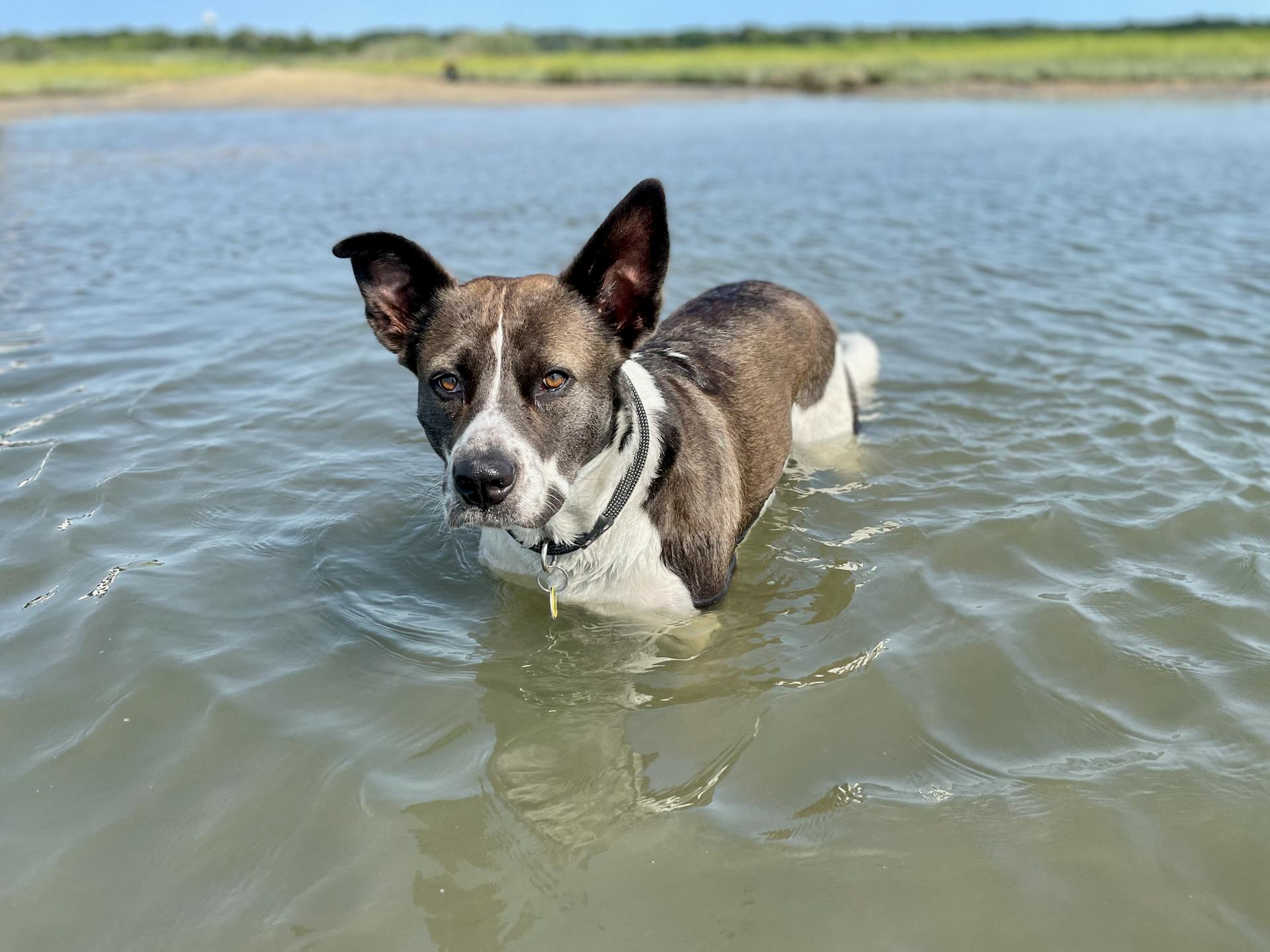
Canine Leishmaniasis is a serious global health concern that affects dogs worldwide. This disease is caused by a parasite called Leishmania, which is transmitted through the bite of an infected sandfly.
The parasite is found in over 80 countries, with the highest incidence rates in the Mediterranean region, Latin America, and parts of Asia. Canine Leishmaniasis is a major public health concern in these regions, where it can cause significant morbidity and mortality in dogs.
Leishmaniasis is a zoonotic disease, meaning it can be transmitted from animals to humans. In dogs, the disease can cause a range of symptoms, from skin lesions and swelling to organ failure and death.
You might like: Dog Skin Health
Diagnosis and Detection
Diagnosis of canine leishmaniasis involves a combination of clinical pathology, serologic tests, and PCR. A CBC, biochemical profile, urinalysis, and specific tests to confirm infection are used to diagnose the disease.
Clinical signs such as skin lesions, weight loss, and anemia are often present in dogs with clinical disease, and high antibody titers are found in 80-100% of these dogs. Quantitative serology is particularly sensitive when compatible clinical signs are present.
For another approach, see: What Is Canine Lupus
Several quantitative serologic methods are used to detect anti-Leishmania antibodies, including indirect immunofluorescence assays, ELISA, and direct agglutination assays. Purified recombinant antigens such as rK39 are also used to detect leishmaniosis in dogs and people in several rapid lateral flow formats as screening assays.
Detection of parasite-specific DNA by PCR allows sensitive and specific diagnosis of infection. Several different assays with various target sequences using genomic or kinetoplast DNA (kDNA) have been developed for canine leishmaniosis.
The Centers for Disease Control and Prevention, Iowa State University Department of Pathology, and North Carolina State University College of Veterinary Medicine assist with testing and treatment of Leishmania-positive dogs in the United States. Diagnostic testing includes molecular biology and genetic techniques which provide high accuracy and high sensitivity/specificity.
A study found that approximately 20% of Foxhounds tested using PCR were positive for leishmaniasis, while only 5% were positive using serological/antibody assays. This highlights the importance of using PCR for detection.
Blood and urine tests, along with tissue biopsies, are typically performed to diagnose leishmaniasis. A PCR blood test is often sent to a laboratory for analysis, as it has the best chance of detecting the disease.
You might like: Canine Leishmaniasis Treatment
Treatment and Management
There is no cure for canine leishmaniasis, but various treatment options are available. These options vary by geographic area, strain of infection, and exhibited symptoms.
Treatment for leishmaniasis in dogs typically involves a combination of medications. Sodium stibogluconate has been used, but it's difficult to obtain. Alternative treatments include meglumine antimonite, allopurinol with or without domperidone, and marbofloxacin.
Intravenous fluids, special therapeutic diets, and antibiotics may also be used to support treatment. Solitary skin lesions can be removed surgically. However, dogs may relapse even after treatment.
Treatment protocols often involve long-term medication, typically lasting 6-12 months. Allopurinol is commonly used, either alone or in combination with other medications. Miltefosine is another option, often used in combination with allopurinol.
Some treatments have side effects, such as local pain at the injection site, pancreatitis, and nephrotoxicity. Treatment may not provide a sterilizing cure, and dogs can remain carriers of the infection, potentially relapsing in the future.
Check this out: Lick Granuloma Dog Home Treatment
The following table summarizes some common chemotherapeutic options for leishmaniasis:
Early treatment is essential to prevent symptoms from progressing. If you suspect your dog has been exposed to leishmaniasis, consult your veterinarian as soon as possible.
Prevention and Control
Preventing canine leishmaniasis requires a multi-faceted approach that includes protecting your dog from sand fly bites and using vaccines when available.
Specific repellent topical insecticides like deltamethrin-impregnated collars and spot-on formulations of permethrin and imidacloprid have been shown to effectively reduce sand fly bites.
Keeping dogs indoors during peak sand fly hours, typically at dusk and dawn, will help minimize exposure.
Deltamethrin collars have been proven to be 86% effective in preventing sand fly bites.
Unfortunately, there is no single vaccine that covers multiple Leishmania species, so different vaccines may be needed for different species.
The Leshmune vaccine, released in Brazil in 2003, has shown up to 87% protection against L. donovani and may also be effective against L. chagasi.
Vaccination and immunotherapy may also be a treatment for ongoing L. infantum infection in dogs.
Consult with your vet before traveling to a Leishmania-endemic area to determine the best course of action for your dog's safety.
Transmission and Spread
Canine leishmaniasis can be transmitted through several routes, including vector-borne by phlebotomine sand flies, vertically from dam to pup, and potentially through transfusion of blood products from infected dogs.
Sand flies are the main vectors of Leishmania parasites, but only a minority of sand fly species are competent vectors. Dogs with or without clinical signs can be infectious to sand flies and transmit the parasites.
Direct dog-to-dog transmission through contact has been reported in several cases, often involving household fighting or contact with diseased dogs. This mode of transmission is rare but possible.
Leishmania parasites can also be transmitted from an infected dam to its offspring, a process known as congenital vertical transmission. This has been reported in several cases.
In the United States, a unique strain of L. infantum (Mon1) has been found to be transmitted from dog to dog through direct contamination with blood and secretions, as well as transplacentally from an infected bitch to her pups.
Recommended read: Skin Parasites Dogs
Geographical and Epidemiological
Canine leishmaniasis is a significant concern in many parts of the world, particularly in the Mediterranean region and parts of South America.
The disease is primarily found in areas with warm and humid climates, where the parasite that causes leishmaniasis, Leishmania infantum, is most active.
In the Mediterranean region, canine leishmaniasis is most prevalent in countries such as Italy, Spain, and Portugal, where the disease has been reported in over 90% of dog populations.
In these areas, the disease is often spread through the bite of an infected sandfly, which can be found in urban and rural areas alike.
Take a look at this: Canine Vector-borne Disease
Zoonotic Importance
Dogs are the main reservoir of infection for human visceral leishmaniosis caused by L infantum. This means they're the primary source of the disease in areas where it's endemic.
Human visceral leishmaniosis is a serious public health problem in these areas. It's an opportunistic disease, which means it takes advantage of people with weakened immune systems.
Curious to learn more? Check out: Autoimmune Disease in German Shepherds
Malnutrition and other immune-altering diseases, including HIV infection, are key risk factors for the disease. This is why people with HIV are more susceptible to leishmaniosis coinfection.
HIV and leishmaniosis coinfection has been reported in over 80 countries worldwide. Control of leishmaniosis returns when there's a sufficient CD4+ T cell population after treatment with combination antiretroviral therapy.
Geographical Distribution
The geographical distribution of a particular condition is a crucial aspect to consider when understanding its epidemiology.
The condition is most prevalent in tropical and subtropical regions of the world, where the climate is warm and humid.
According to data, the condition is found in over 100 countries worldwide, with the highest incidence rates reported in Southeast Asia and sub-Saharan Africa.
In these regions, the condition is often linked to poor sanitation and lack of access to clean water, which can lead to the spread of the disease.
The condition is also found in other parts of the world, including Latin America and the Caribbean, where it is often associated with poverty and lack of healthcare resources.
In some areas, the condition is more common in certain populations, such as children and young adults, due to their increased exposure to the environment and behaviors that put them at higher risk.
Etiology in the Americas
In the Americas, several Leishmania species have been reported in dogs, including Leishmania amazonensis, Leishmania braziliensis, Leishmania guyanensis, Leishmania infantum, Leishmania mexicana, Leishmania panamensis, Leishmania peruviana, and Leishmania naiffi.
Leishmania colombiensis and Leishmania pifanoi were previously thought to be causative agents of canine leishmaniasis in the Americas, but they've since been removed from the list.
Leishmania pifanoi was initially misidentified as L. pifanoi in a 1990 report from Ecuador, but further analysis revealed it to be L. mexicana, a species found in Venezuela.
Leishmania colombiensis was reported in a dog from Venezuela, but its pathogenicity to dogs is still uncertain.
Interestingly, Leishmania colombiensis has since been transferred to the genus Endotrypanum, and its potential to cause disease in dogs requires further investigation.
Clinical and Prognostic
Canine leishmaniasis is a multisystemic disease with a highly variable spectrum of immune responses and clinical manifestations.
Clinical disease is associated with a marked antibody response that does not confer protection, and immune-mediated mechanisms are responsible for much of the pathology in canine leishmaniasis.
The typical history reported by owners of dogs with clinical disease includes the appearance of skin lesions, ocular abnormalities, or epistaxis, often accompanied by weight loss, exercise intolerance, and lethargy.
Dermal abnormalities are found in 80%–90% of dogs, lymphadenomegaly in 62%–90%, ocular disease in 16%–81%, splenomegaly in 10%–53%, and abnormal nail growth (onychogryphosis) in 20%–31% of dogs.
Clinical laboratory findings include mild to moderate nonregenerative or rarely regenerative anemia in 60%–73% of dogs, and serum hyperproteinemia with hyperglobulinemia and hypoalbuminemia, frequently expressed by a decreased albumin:globulin ratio.
The prognosis for a dog diagnosed with leishmaniasis is guarded to grave, with many dogs dying from resulting kidney failure.
Severely ill dogs may not be able to undergo treatment, and a complete clinical evaluation of dogs with cutaneous leishmaniasis may be important, especially for geriatric dogs or dogs with other underlying medical conditions.
Curious to learn more? Check out: Canine Ocular Lymphoma
Frequently Asked Questions
Can a dog be cured of Leishmania?
Unfortunately, there is no cure for Leishmania in dogs, and they may experience relapses. Treatment focuses on managing symptoms and preventing complications.
Is leishmaniasis in dogs in the US?
Leishmaniasis in dogs is not typically found in the US, but cases have been increasing in North America. If you're concerned about your dog's health, learn more about this disease and its risks
How long can a dog live with Leishmania?
Dogs with Leishmania can lead normal lives for many years with proper veterinary care. Regular health monitoring with a vet is crucial to determine the best treatment plan.
Can I bring a dog with leishmaniasis to the USA?
No, it's not recommended to bring a dog with leishmaniasis to the USA, as it's best to treat the condition locally with a veterinarian. Imported dogs with leishmaniasis have been detected in the US, primarily from countries like Bangladesh, Brazil, India, and Sudan
What are the first symptoms of leishmaniasis in dogs?
The first symptoms of leishmaniasis in dogs often include skin problems, such as lesions and hair loss, particularly around the head and pressure points, as well as weight loss and lethargy. If you suspect your dog has leishmaniasis, consult a veterinarian for proper diagnosis and treatment.
Sources
- https://vcahospitals.com/know-your-pet/leishmaniasis-in-dogs
- https://www.merckvetmanual.com/generalized-conditions/leishmaniosis/leishmaniosis-in-dogs
- https://parasitesandvectors.biomedcentral.com/articles/10.1186/s13071-024-06282-w
- https://en.wikipedia.org/wiki/Canine_leishmaniasis
- https://www.webmd.com/pets/dogs/what-is-leishmaniasis-dogs
Featured Images: pexels.com


